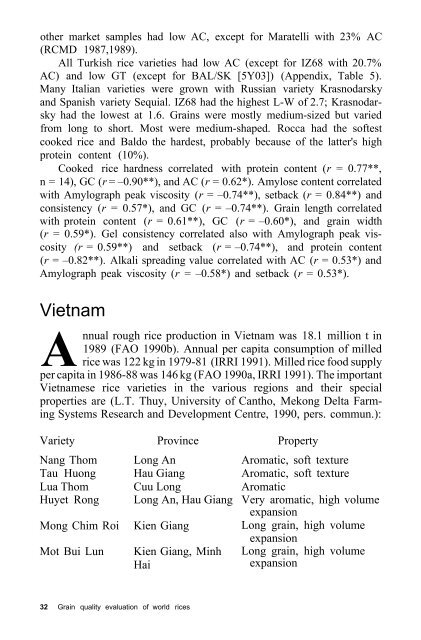Juliano et al. - 1993 - Grain Quality Evaluation of World Rices
Juliano et al. - 1993 - Grain Quality Evaluation of World Rices
Juliano et al. - 1993 - Grain Quality Evaluation of World Rices
Create successful ePaper yourself
Turn your PDF publications into a flip-book with our unique Google optimized e-Paper software.
other mark<strong>et</strong> samples had low AC, except for Maratelli with 23% AC<br />
(RCMD 1987,1989).<br />
All Turkish rice vari<strong>et</strong>ies had low AC (except for IZ68 with 20.7%<br />
AC) and low GT (except for BAL/SK [5Y03]) (Appendix, Table 5).<br />
Many It<strong>al</strong>ian vari<strong>et</strong>ies were grown with Russian vari<strong>et</strong>y Krasnodarsky<br />
and Spanish vari<strong>et</strong>y Sequi<strong>al</strong>. IZ68 had the highest L-W <strong>of</strong> 2.7; Krasnodarsky<br />
had the lowest at 1.6. <strong>Grain</strong>s were mostly medium-sized but varied<br />
from long to short. Most were medium-shaped. Rocca had the s<strong>of</strong>test<br />
cooked rice and B<strong>al</strong>do the hardest, probably because <strong>of</strong> the latter's high<br />
protein content (10%).<br />
Cooked rice hardness correlated with protein content ( r = 0.77**,<br />
n = 14), GC ( r = –0.90**), and AC ( r = 0.62*). Amylose content correlated<br />
with Amylograph peak viscosity ( r = –0.74**), s<strong>et</strong>back ( r = 0.84**) and<br />
consistency ( r = 0.57*), and GC ( r = –0.74**). <strong>Grain</strong> length correlated<br />
with protein content ( r = 0.61**), GC ( r = –0.60*), and grain width<br />
( r = 0.59*). Gel consistency correlated <strong>al</strong>so with Amylograph peak viscosity<br />
( r = 0.59**) and s<strong>et</strong>back ( r = –0.74**), and protein content<br />
( r = –0.82**). Alk<strong>al</strong>i spreading v<strong>al</strong>ue correlated with AC ( r = 0.53*) and<br />
Amylograph peak viscosity ( r = –0.58*) and s<strong>et</strong>back ( r = 0.53*).<br />
Vi<strong>et</strong>nam<br />
A<br />
nnu<strong>al</strong><br />
rough rice production in Vi<strong>et</strong>nam was 18.1 million t in<br />
1989 (FAO 1990b). Annu<strong>al</strong> per capita consumption <strong>of</strong> milled<br />
rice was 122 kg in 1979-81 (IRRI 1991). Milled rice food supply<br />
per capita in 1986-88 was 146 kg (FAO 1990a, IRRI 1991). The important<br />
Vi<strong>et</strong>namese rice vari<strong>et</strong>ies in the various regions and their speci<strong>al</strong><br />
properties are (L.T. Thuy, University <strong>of</strong> Cantho, Mekong Delta Farming<br />
Systems Research and Development Centre, 1990, pers. commun.):<br />
Vari<strong>et</strong>y Province Property<br />
Nang Thom Long An Aromatic, s<strong>of</strong>t texture<br />
Tau Huong Hau Giang Aromatic, s<strong>of</strong>t texture<br />
Lua Thom Cuu Long Aromatic<br />
Huy<strong>et</strong> Rong Long An, Hau Giang Very aromatic, high volume<br />
Mong Chim Roi Kien Giang<br />
expansion<br />
Long grain, high volume<br />
expansion<br />
Mot Bui Lun Kien Giang, Minh Long grain, high volume<br />
Hai<br />
expansion<br />
32 <strong>Grain</strong> qu<strong>al</strong>ity ev<strong>al</strong>uation <strong>of</strong> world rices

















